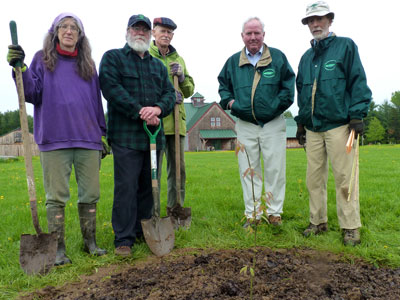 |
| Glen Rea, president of the Maine chapter of the American Chestnut Foundation, studies the growth rings of an American chestnut while Joe Dupere, MOFGA’s landscape coordinator, looks on. English photo. |
By Jean English
On May 20, 2011, a small group of dedicated chestnut enthusiasts met at MOFGA’s Common Ground Education Center to plant two blight resistant American chestnut trees on the grounds. Eric Evans, the breeding coordinator and vice president of the Maine Chapter of The American Chestnut Foundation, grew the trees from seed obtained from Virginia – the sixth generation product of backcrossing American chestnut to blight resistant Chinese chestnut. After spending a year in Evans’ Camden, Maine, nursery, the 2- to 3-foot-tall specimens were ready for transplanting.
Chestnut blight, a fungus, hit New York in the early 1900s and gradually spread. Without blight, a chestnut can live for 300 to 400 years. MOFGA member Charlie Hudson, who manages a chestnut orchard in Unity and who participated in the planting, said he has heard of some European chestnuts that lived for more than 1,000 years.
The two trees planted on the Common at MOFGA’s site “are some of the first blight-resistant trees distributed to the state chapters from the breeding program in Virginia, and signal the beginning of rapidly expanding potential for restoration of chestnuts in our forests and an acknowledgement of MOFGA’s support of our work in Maine,” said Evans. In 2008, 29 wild Maine American chestnut trees were planted on MOFGA’s grounds, some in the open and some in the woods.
Although chestnut trees have male and female flowers on the same tree, they are self-infertile and need another tree nearby for pollination. The two planted at MOFGA on May 20 were dedicated to Rachel Carson (by Sharon Tisher) and to William J. Raich (Nancy Rosalie’s father).
Joe Dupere, MOFGA’s landscape coordinator, and Nancy Rosalie, from MOFGA’s landscaping committee, had prepared 5-foot-wide, 2-foot-deep planting areas in soil with a pH of about 5.7. Chestnut trees must have a well-drained soil but will tolerate a range of pH values, ideally below pH 6.
Maine Chapter president Glen Rea, also present for the planting (and also chairman of the national Foundation’s board of directors), said one tree growing in Bradley, Maine, where the American Chestnut Foundation is putting in a seed orchard, is doing well in a soil with a pH of 5.7.
 |
 |
| One of two blight resistant American chestnut trees planted on MOFGA’s grounds in May 2011. English photo. | The trees are the sixth generation of a breeding program by the American Chestnut Foundation in Virginia. English photo. |
The American Chestnut Foundation, formed in 1983, has 16 state chapters from Georgia to Maine. Its primary activity has been backcross breeding – i.e., transferring resistance to American chestnut from, primarily, Chinese chestnut, testing each new generation for blight resistance, and selecting the best trees from those tests to backcross again. The sixth generation of the breeding program in Virginia is highly blight resistant, said Rea. (The process is described in detail at www.acf.org/pdfs/about/restoration.pdf.)
“We thought it would take 40 years to get the current level of resistance,” said Rea. “It took 25.” He attributed that success to “a lot of confident people working hard” and to the approximately $29 million the Foundation has spent to date.
Even native trees that have not been bred and selected for blight resistance are valuable. Evans explained that those trees begin producing seed when they’re about 7 years old and can live for 20 to 25 years before they succumb to blight; so they supply mast for wildlife for several years – an important point. “The wildlife population is suffering because the beech are dying out” [from beech bark disease], said Evans. “So the chestnut is coming in at a good time for deer, bears and turkeys.”
Maine’s state champion tree grows in Atkinson, about 40 miles north of Bangor – but it was within 5 minutes of being cut down at one point.
 |
 |
| Nancy Rosalie of MOFGA’s landscape committee, Joe Dupere, and Charlie Hudson (center), Glen Rea and Eric Evans of the Maine Chapter of the American Chestnut Foundation. English photo. | Learn about American chestnuts from the Maine Chapter of the American Chestnut Foundation in the Environmental Concerns Area at the Common Ground Country Fair. Here, Norma Jones holds an American chestnut branch at the 2008 Fair. English photo. |
“It was in the way of a harvest,” said Rea. A logger noticed the chestnut’s distinctive seed bur on the ground and called a forester, who got it identified, and that stopped the cutting. That tree is now about 75 feet tall and 34 inches in diameter at breast height.
A 75-year-old tree that had grown in Atkinson until it died of blight had grown 1 inch per year in diameter.
The Northeast Wilderness Trust now owns the Atkinson forest, which hosts an important natural grove of some 300 trees, of which six are producing nuts.
“Maine is coming along nicely with our breeding program,” said Rea. “We’re about 8 years away from having blight resistance.”
More information about American chestnuts is available from The American Chestnut Foundation, www.acf.org, and the Maine Chapter of The American Chestnut Foundation, www.me-acf.org. The Maine chapter has a booth in the Environmental Concerns Area of the Common Ground Country Fair.
